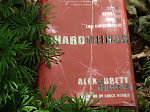P.S. By the way ... WALL-E is HILARIOUS!! Not to mention those awesome Pixar shorts. I've seen it twice now. :D
P.S. II. I feel sorry for you guys ... but keep telling yourself that the trailer for Beverly Hills Chihuahua only lasts a couple of minutes. If you do that, you'll be just fine. :-)
WALL•E world
Filmmaker Andrew Stanton says his latest film isn't about the environment or obesity. It's about relationships | Megan Basham
With its first feature-length film in 1995, Toy Story, Pixar changed the face of children's entertainment in Hollywood. Its innovative 3-D computer animation not only looked different, it told stories with a depth and humor that appealed to adults almost as much as kids.
As the second animator hired by the studio, Andrew Stanton has been a constant force in shaping the creative direction of the studio's productions. He has done so to amazing success. Finding Nemo, which Stanton wrote and directed, stands as the highest-grossing G-rated film of all time. Of the top 10 films in that category, Stanton, now vice-president of Pixar's creative division, was writer, director, or producer on five.
With his latest film, WALL•E, about to hit theaters, the Christian filmmaker sat down with WORLD.
WORLD: Pixar has built a reputation not only for innovative visuals but for original storytelling with Finding Nemo, The Incredibles, Ratatouille, and others. How have you managed to maintain your integrity in a field that is famous for making lazy grabs at parents' wallets?
STANTON: When Toy Story came out the media was making such a big deal about the technology, but what we were really interested in was the story. At the time everybody thought that the only way you could do an animated movie was to make it a musical fairy tale. We set out to prove that animation is not a genre, it's a medium that can be anything it wants to be like any other movie.
And we've worked very hard to keep Pixar a director-driven studio where each of our films is conceived, inspired, and executed by a singular vision. I think that ensures it will be art first and a product second. It's a lot harder to make a good movie when you try to make a product first with a little bit of art in it.
WORLD: How does WALL•E represent your singular vision?
STANTON: Well, what really interested me was the idea of the most human thing in the universe being a machine because it has more interest in finding out what the point of living is than actual people. The greatest commandment Christ gives us is to love, but that's not always our priority. So I came up with this premise that could demonstrate what I was trying to say—that irrational love defeats the world's programming. You've got these two robots that are trying to go above their basest directives, literally their programming, to experience love.
With the human characters I wanted to show that our programming is the routines and habits that distract us to the point that we're not really making connections to the people next to us. We're not engaging in relationships, which are the point of living—relationship with God and relationship with other people.
WORLD: The depiction of humanity is pretty stark in this movie.
STANTON: Well, when I started outlining humanity in the story, I asked myself: What if everything you needed to survive—health care, food—was taken care of and you had nothing but a perpetual vacation to fill your time? What if the result of all that convenience was that all your relationships became indirect—nobody's reaching out to each other? A lot of people have suggested that I was making a comment on obesity. But that wasn't it, I was trying to make humanity big babies because there was no reason for them to grow up anymore.
WORLD: Now that you mention people misconstruing your intentions, how do you feel about reports that WALL•E is an environmental movie?
STANTON: People made this connection that I never saw coming with the environmental movement, and that's not what I was trying to do. I was just using the circumstances of people abandoning the Earth because it's filled with garbage as a way to tell my story.
I always knew that I wanted WALL•E to be digging through trash for two reasons: One, I wanted him to be the lowest on the totem pole. It's a janitorial job; it's the saddest, lowest status amongst his kind; and it just makes him that much more of a lonely guy. Two, trash is really visual. Even the littlest kid understands when there's stuff in the way and it needs to be picked up, so I didn't need to spend time explaining his job. And then I just reverse-engineered from there, "OK, if there's trash everywhere, how did it get there?"
WORLD: As someone who is completely freaked out by rats, I was amazed that in Ratatouille you managed to make rats lovable. Now, in WALL•E, you've done something even more amazing—you've made cockroaches loveable!
STANTON: [Laughing] Yeah, we [the animators] took that as a personal challenge. We said, let's not even design it cute—we'll make it look like a real cockroach and we'll still make it cute! I'm glad you think we succeeded.
[Separate Sidebar]



1 comment:
I knew I wanted to see WALL-E just because it's a Pixar movie, but now I really want to see it! Thanks for sharing that article!
And to think I have to wait 'til it comes to the drive-in. :-(
-Melanie H.
Post a Comment